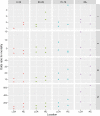A Belgian Population-Based Study Reveals Subgroups of Right-sided Colorectal Cancer with a Better Prognosis Compared to Left-sided Cancer
- PMID: 37071802
- PMCID: PMC10243787
- DOI: 10.1093/oncolo/oyad074
A Belgian Population-Based Study Reveals Subgroups of Right-sided Colorectal Cancer with a Better Prognosis Compared to Left-sided Cancer
Abstract
Background: Patients with left-sided colorectal cancer (L-CRC) are known to have a significantly better prognosis than those with right-sided CRC (R-CRC). It has been hypothesized that RAS, BRAF mutations, or deficient mismatch repair status (MMR) might be responsible for the prognostic effect of primary tumor location (PTL). This study aims to evaluate the prognostic effect of PTL in the Belgian population and to determine the role of biomarkers (MMR, BRAF, and RAS status) in this effect.
Patients and methods: We performed a retrospective analysis of Belgian Cancer Registry data. First, we studied the prognostic effect of PTL on 5-year relative survival of 91,946 patients diagnosed with CRC (all stages) from 2004-2015. Second, we investigated the interaction between biomarkers and the prognostic effect of PTL in 1818 patients diagnosed with stage IV CRC in 2014-2015.
Results: L-CRC was associated with a significantly better 5-year relative survival compared to R-CRC in all stages and ages combined (68.4%, 95% CI, 67.7-69.1% vs 65.6%, 95% CI, 64.7-66.4%). Also, when stratified by age, sex, and stage, the prognosis of L-CRC was better compared to R-CRC in most subgroups. Only in stage II and certain subgroups of elderly patients, the opposite was observed. Furthermore, our data showed that none of the biomarkers had a significant interaction with the effect of PTL on survival.
Conclusion: This population-based study confirms that L-CRC is associated with significantly better relative survival compared to R-CRC, in all stages and ages combined. Furthermore, in stage IV L-CRC is associated with a longer survival than R-CRC, regardless of MMR, RAS, and BRAF status.
Keywords: colorectal neoplasms; population register; primary tumor location; survival; tumor biomarkers.
© The Author(s) 2023. Published by Oxford University Press.
Conflict of interest statement
The authors indicated no financial relationships.
Figures



Similar articles
-
Association of Prognostic Value of Primary Tumor Location in Stage III Colon Cancer With RAS and BRAF Mutational Status.JAMA Oncol. 2018 Jul 12;4(7):e173695. doi: 10.1001/jamaoncol.2017.3695. Epub 2018 Jul 12. JAMA Oncol. 2018. PMID: 29167892 Free PMC article.
-
Deficient DNA mismatch repair is associated with favorable prognosis in Thai patients with sporadic colorectal cancer.World J Gastroenterol. 2015 Jan 21;21(3):926-34. doi: 10.3748/wjg.v21.i3.926. World J Gastroenterol. 2015. PMID: 25624727 Free PMC article.
-
The Prognostic Utilities of DNA Mismatch Repair Status and KRAS and BRAF Mutation in Korean Colorectal Cancer Patients: The KASID Multicenter Study.Oncology. 2023;101(1):49-58. doi: 10.1159/000527285. Epub 2022 Oct 3. Oncology. 2023. PMID: 36191562 Free PMC article.
-
The prognostic value of KRAS and BRAF in stage I-III colorectal cancer. A systematic review.Ann Ital Chir. 2019;90:127-137. Ann Ital Chir. 2019. PMID: 30739887
-
Pathological complete response with anti-PD-1 therapy in a patient with microsatellite instable high, BRAF mutant metastatic colon cancer: a case report and review of literature.Discov Med. 2016 May;21(117):341-7. Discov Med. 2016. PMID: 27355330 Review.
Cited by
-
Prediction of 5-year postoperative survival and analysis of key prognostic factors in stage III colorectal cancer patients using novel machine learning algorithms.Front Oncol. 2025 Jul 14;15:1604386. doi: 10.3389/fonc.2025.1604386. eCollection 2025. Front Oncol. 2025. PMID: 40727467 Free PMC article.
References
MeSH terms
Substances
LinkOut - more resources
Full Text Sources
Medical
Research Materials

